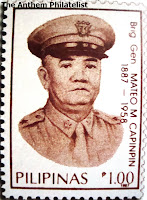Andres Bonifacio on Stamps

Andres Bonifacio was born into a poor family and was orphaned at age fourteen. He had to discontinue his education to work at odd jobs to support his younger brothers and sisters. He continued his education by reading books. Victor Hugo's Les Miserables was one of his favorites and Rizal's novels inspired his ideals for a free Philippines. Bonifacio founded the secret society, the Katipunan on July 7, 1892.
Philippine historiography at the turn of the 20th century tended to neglect Bonifacio's seminal leadership of the Philippine Revolution. Under the auspices of the American colonial educators, a systematic attempt was made to cast aside Bonifacio and insist on Rizal as the prototypical national hero. For example in 1912, an important decision was made by the Americans in connection with the inauguration of the Rizal Monument in what was then Luneta Park, and the subsequent national commemoration of his death anniversary.
Esteban A. de Ocampo of the National Historical Institute recounted the events leading to the decision of Governor William Taft in choosing Rizal as the Philippines' national hero. Taft said: "'And now, gentlemen, you must have a national hero.' These were supposed to be the words addressed by Governor Taft to Messrs. Trinidad Pardo De Tavera, Benito Legarda Jr., and Luzurriaga, Filipino members of the Philippine Commission of which Taft was the chairman. It was further reported that 'in the subsequent discussion in which the rival merits of the revolutionary heroes (Marcelo H. del Pilar, Graciano Lopez-Jaena, Rizal, General Antonio N. Luna, Emilio Jacinto, and Bonifacio) were considered, the final choice - now universally acclaimed a wise one - was Rizal. And so history was made.'"
Since then, the debate of Rizal versus Bonifacio has remained unabated, mercilessly pitting the qualities of one against the other: the ilustrado class versus the proletariat, the sophisticated European education versus the self-schooled one, the priviledged situation of one versus the plebeian beginnings of the other, Rizal's mastery of Spanish versus Bonifacio's Tagalog background, and the list goes on. As a result, a prejudiced view of Bonifacio persisted in almost all Philippine history books.
In 1956, the publication of a landmark book in Philippine historiography changed the historical and intellectual treatment of Bonifacio. Teodoro Agoncillo's Revolt of the Masses advanced the view that Bonifacio's accomplishments were worthy of the accolades given to a national hero, and that the Philippine revolution was primarily driven by the masses. These theses were encapsulated in a classic Marxist dialectic, beginning the rise of a distinctly nationalist historiography, aimed at reappropriating the signs and symbols of the nation.
A new line of Philippine history books based on the nationalist discourse of Agoncillo followed, culminating with Reynaldo Ileto's Pasyon and Revolution in 1979. Ileto's book started the trend of studying history using unofficial documents, textual references in plays, oral tradition, and other similar sources. History from below, as it came to be known, focuses on the story, achievements, and contributions of sectors of society that were either neglected or cast aside for various reasons.
This nationalist trend would eventually be challenged by other historians. On April 7, 1995, American scholar Glenn Anthony May of the University of Oregon delivered a paper entitled, "Andres Bonifacio: Inventing a Hero" at a meeting of the Association for Asian Studies (AAS) in Washington, D.C. In this paper and the subsequent book, Inventing a Hero: The Posthumous Re-Creation of Andres Bonifacio, May revealed in very strong words that the Bonifacio story was "a story of a fabrication of a national hero -- a history of deception, dissimulation, and distortion....all that can be reliably known is the illusion itself, the product of doctored, spurious, or undocumented sources and the collective imagination of several generations of historians."
Various scholars, academicians, and historians attacked May's thesis that Bonifacio's accomplishments and certain portions of his life were mere fabrication of some Filipino nationalist historians. Malcolm Churchill contended that May was not savaging and degrading the honor and memory of Bonifacio but was making a name and building a reputation of being a revisionist historian in the Philippine and American academic community.
The stamp was issued on November 30, 1963.






